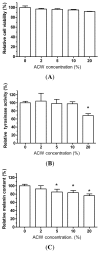Biological properties of acidic cosmetic water from seawater
- PMID: 22754342
- PMCID: PMC3382787
- DOI: 10.3390/ijms13055952
Biological properties of acidic cosmetic water from seawater
Abstract
This current work was to investigate the biological effects of acidic cosmetic water (ACW) on various biological assays. ACW was isolated from seawater and demonstrated several bio-functions at various concentration ranges. ACW showed a satisfactory effect against Staphylococcus aureus, which reduced 90% of bacterial growth after a 5-second exposure. We used cultured human peripheral blood mononuclear cells (PBMCs) to test the properties of ACW in inflammatory cytokine release, and it did not induce inflammatory cytokine release from un-stimulated, normal PBMCs. However, ACW was able to inhibit bacterial lipopolysaccharide (LPS)-induced inflammatory cytokine TNF-α released from PBMCs, showing an anti-inflammation potential. Furthermore, ACW did not stimulate the rat basophilic leukemia cell (RBL-2H3) related allergy response on de-granulation. Our data presented ACW with a strong anti-oxidative ability in a superoxide anion radical scavenging assay. In mass spectrometry information, magnesium and zinc ions demonstrated bio-functional detections for anti-inflammation as well as other metal ions such as potassium and calcium were observed. ACW also had minor tyrosinase and melanin decreasing activities in human epidermal melanocytes (HEMn-MP) without apparent cytotoxicity. In addition, the cell proliferation assay illustrated anti-growth and anti-migration effects of ACW on human skin melanoma cells (A375.S2) indicating that it exerted the anti-cancer potential against skin cancer. The results obtained from biological assays showed that ACW possessed multiple bioactivities, including anti-microorganism, anti-inflammation, allergy-free, antioxidant, anti-melanin and anticancer properties. To our knowledge, this was the first report presenting these bioactivities on ACW.
Keywords: acidic cosmetic water (ACW); allergy-free; anti-inflammation; anti-melanoma; anti-microorganism; antioxidant activity; skin-whitening.
Figures







Similar articles
-
Comparative biological study of roots, stems, leaves, and seeds of Angelica shikokiana Makino.J Ethnopharmacol. 2013 Jul 30;148(3):980-7. doi: 10.1016/j.jep.2013.06.008. Epub 2013 Jun 12. J Ethnopharmacol. 2013. PMID: 23769982
-
Polygonum cuspidatum extracts as bioactive antioxidaion, anti-tyrosinase, immune stimulation and anticancer agents.J Biosci Bioeng. 2015 Apr;119(4):464-9. doi: 10.1016/j.jbiosc.2014.09.008. Epub 2014 Oct 12. J Biosci Bioeng. 2015. PMID: 25311751
-
Chemical Evaluation, Antioxidant, Antiproliferative, Anti-Inflammatory and Antibacterial Activities of Organic Extract and Semi-Purified Fractions of the Adriatic Sea Fan, Eunicella cavolini.Molecules. 2021 Sep 23;26(19):5751. doi: 10.3390/molecules26195751. Molecules. 2021. PMID: 34641295 Free PMC article.
-
Composition and Bioactivity of Essential Oil from Citrus grandis (L.) Osbeck 'Mato Peiyu' Leaf.Molecules. 2017 Dec 5;22(12):2154. doi: 10.3390/molecules22122154. Molecules. 2017. PMID: 29206180 Free PMC article.
-
Comparison of in vitro tests for antioxidant and immunomodulatory capacities of compounds.Phytomedicine. 2014 Jan 15;21(2):164-71. doi: 10.1016/j.phymed.2013.08.008. Epub 2013 Sep 14. Phytomedicine. 2014. PMID: 24041614 Review.
Cited by
-
Biofunctional constituents from Liriodendron tulipifera with antioxidants and anti-melanogenic properties.Int J Mol Sci. 2013 Jan 15;14(1):1698-712. doi: 10.3390/ijms14011698. Int J Mol Sci. 2013. PMID: 23322020 Free PMC article.
-
4-(Phenylsulfanyl)butan-2-One Suppresses Melanin Synthesis and Melanosome Maturation In Vitro and In Vivo.Int J Mol Sci. 2015 Aug 26;16(9):20240-57. doi: 10.3390/ijms160920240. Int J Mol Sci. 2015. PMID: 26343635 Free PMC article.
-
Therapeutics for Inflammatory-Related Diseases Based on Plasmon-Activated Water: A Review.Int J Mol Sci. 2018 May 28;19(6):1589. doi: 10.3390/ijms19061589. Int J Mol Sci. 2018. PMID: 29843406 Free PMC article. Review.
-
Biofunctional Constituents from Michelia compressa var. lanyuensis with Anti-Melanogenic Properties.Molecules. 2015 Jul 3;20(7):12166-74. doi: 10.3390/molecules200712166. Molecules. 2015. PMID: 26151114 Free PMC article.
-
Strategy on Persisting in Distinct Activity of Plasmon-Activated Water.ACS Omega. 2019 Dec 3;4(25):21197-21203. doi: 10.1021/acsomega.9b02627. eCollection 2019 Dec 17. ACS Omega. 2019. PMID: 31867513 Free PMC article.
References
-
- Shimizu Y., Furusawa T. Killing action of virus, bacteria and fungus by oxidative potential water induced by electrolysis. J. Dent. Med. 1992;36:1055–1060.
-
- Mori Y., Komatsu S., Hata Y. Toxicity of electrolyzed strong acid aqueous solution-subacute toxicity test and effect on oral tissue in rats. Odontology. 1997;84:619–626.
-
- Kohno S., Kawata T., Kaku M., Fuita T., Tsutsui K., Ohtani J., Tenjo K., Motokawa M., Tohma Y., Shigekawa M., et al. Bactericidal effects of acidic electrolyzed water on the dental unit waterline. Jpn. J. Infect. Dis. 2004;57:52–54. - PubMed
-
- Shimmura S., Matsumoto K., Yaguchi H., Okuda T., Miyajima S., Negi A., Shimazaki J., Tsubot K. Acidic electrolysed water in the disinfection of the ocular surface. Exp. Eye Res. 2000;70:1–6. - PubMed
-
- Harrington L.E., Hatton R.D., Mangan P.R., Turner H., Murphy T.L., Murphy K.M., Weaver C.T. Interleukin 17-producing CD4+ effector T cells develop via a lineage distinct from the T helper type 1 and 2 lineages. Nat. Immunol. 2005;6:1123–1132. - PubMed
Publication types
MeSH terms
Substances
LinkOut - more resources
Full Text Sources
Medical

